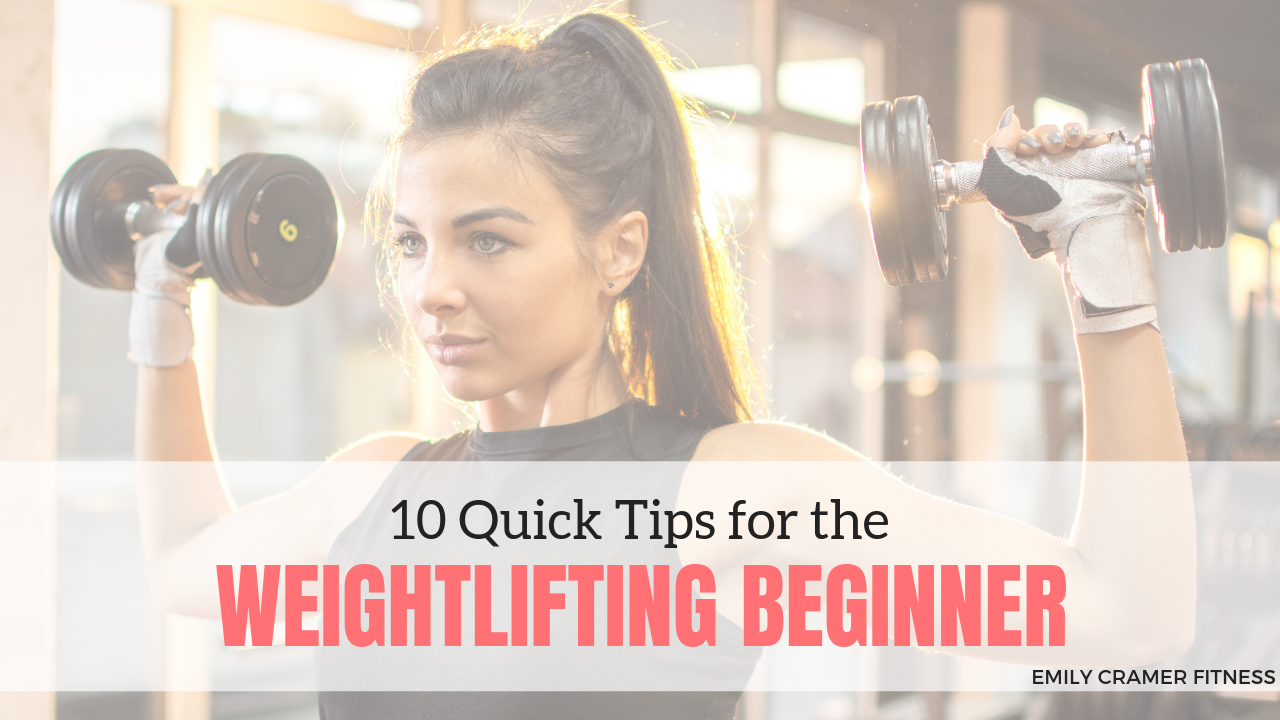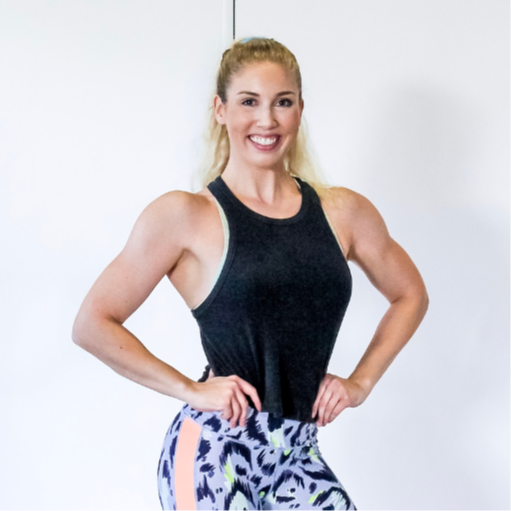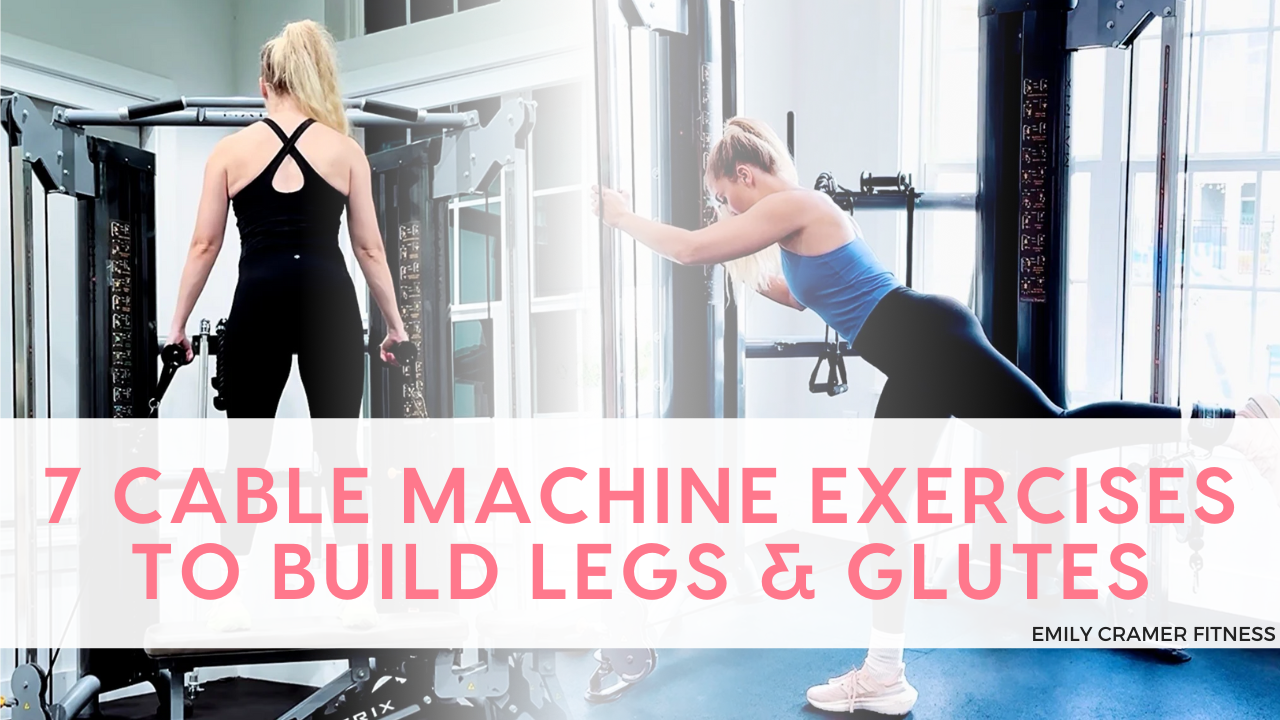
10 Quick Tips for the Weight Lifting Beginner
New to weight lifting?
I know it can be overwhelming to get started. There's so much to learn! It's a gradual process just to learn what exercises work each muscle and how to perform them. Then add to that figuring out reps, sets, training splits, etc.
I remember being in your shoes. These 10 tips stem from the things I wish I knew at that stage of my fitness journey in addition to the questions I get asked most often by my online clients.
Pin these tips for later

1. Slow down the negative.
Every exercise movement is made up of three portions:
The concentric portion of the movement is the part where you're lifting the weight. This is where you're fighting against the resistance.
The isometric portion of the movement is the part where you've reached the full muscle contraction and your stabilizer muscles are helping you to hold the weight all the way up. You are pausing before lowering the weight back to the starting position.
The eccentric portion of the movement is the part where you're lowering the weight back to the starting position. You're trying to decelerate the return to the starting position as the muscle stretches.
I often see people fly through the eccentric movement. They lift the weight and then "drop" it in one swift motion.
Don't do this!
Slow it down. It helps to count the seconds in your head until you get used to the slower speed. You might need to lift lighter weights.
Slowing down the eccentric part of the movement will increase your time under tension, help you maintain control throughout the movement, and also ensure you're getting the most out of the exercise- aka, you will see results quicker.

2. Mind muscle connection matters.
If you're just going through the motions during your workout, you're missing out on muscle gains!
Mind muscle connection is so important to growing your muscles as effectively as possible.
This means you're mindful of what muscle should be contracting during each exercise. You're focusing on feeling the squeeze where you're supposed to!
This is vital to ensuring proper form. Many people have under and over active muscle groups, which means you're not always using the muscles you're supposed to for each movement.
The glutes, for example are under active for most people while the quads are overactive. Intentionally squeezing the glutes helps you activate them and ensure you're not recruiting the stronger quad muscles to overcompensate during a glutes focused movement.

3. You Need to Eat to Build Muscle
You will see the greatest results in muscle growth by being in a calorie surplus. You need the extra food to lift heavier in the gym and add size.
Even if your primary goal is weight loss and you're using resistance training to supplement that, you need to be eating! Taking calories drastically low to achieve weight loss results is counter productive because you aren't fueling your body with the energy it needs to put fourth its best effort during workouts!
Start tracking your calories and your macronutrients (consumption in grams of protein, carbs, fat, and fiber). You should try to aim for 1 gram of protein per pound of lean body mass.
4. How to Pick the Right Weight for You
The weights you choose for an exercise are of massive importance to your results. You need to challenge yourself but also maintain good form!
I advise all of my clients to pick a weight at which they can perform all prescribed reps of an exercise with good form and (if they absolutely had to) an additional two reps (also with good form.)
You don't want to be failing at the end of every set but you also don't want to stop with another 5-10 reps left in the tank.
A good way to gauge what weight makes sense for you is to perform a light warm up set to get the hang of the motion. Then work your way up from there to find the weight that best fits however many reps you're to perform.
If you aren't challenging your body, it isn't changing. Make sure you can feel the pump and that you're feeling it in the correct place! If you don't feel it where you should, lower the weight and try again with greater focus on form.
5. Don't Skip Muscle Groups
Maybe you just want abs and a booty! So you're only working those two things every session. It seems harmless. But it's not.
Your body is one big chain of muscles. When you start skipping different muscles to favor others, you create imbalances in your body. These imbalances often lead to poor form during workouts as your body learns to compensate for under active muscles by tweaking the movements to primarily recruit synergist muscles instead.
Your body just looks for the easiest way to complete whatever you're asking it to do. So if the helper muscles are stronger than the primary mover, you might end up working the wrong muscle completely, or worse, creating an injury.

6. Invest in a Coach
I am not just saying this because I am a coach (which I am.)
I am a coach who has a coach. My coach has a coach. I have had clients who are also coaches. My point is that we all practice what we preach: investing in your health. This is because we firmly stand behind the value coaching can bring and the speed at which you get results with an expert's help.
Regardless of your level or exercise science and nutrition knowledge, having a third eye to provide an unbiased opinion and keep you on track towards your goals is invaluable.
If I could go back in time, I would have invested in a coach the moment I decided to start weight lifting. It would have saved an immense amount of time spent in the trial and error phase.
Rather than scouring the internet for articles on building my own workout plan and how to best reach "X" goal, I could have had a concrete game plan right from the start under the guidance of someone who knew exactly what I needed to get results.
It takes so much of the fear of failure out of things when you can say, "If I just follow this plan to a T, I am GUARANTEED results."
Additionally, the accountability you receive is priceless. You can Google the world's best workout plan but if you can't give yourself the kick in the butt you need to commit to it, you won't see the results anyways.
Think of it this way, would you rather invest the money in your health up front or invest the years spent trying to figure out the whole thing on your own?
7. Start small and be consistent.
People always try to go all in right from the get go. But slow and steady wins this race! I promise. Start with a small commitment! Hold yourself to 2 or 3 workouts each week.
Once you've proven you can stick to that for 1-2 months, you can increase from there!
Psychologically, you're much more likely to stick to your goals if you take things gradually. You won't wear yourself out and give up if you take it slow.
Consistency is THE single most important factor when it comes to reaching your fitness goals. Make sure that your goals are challenging but realistic!
8. Change the Intensity

In order to continue seeing progress, you need to increase your workout intensity.
There are a couple ways to do this:
You can add reps to each set.
You can decrease your rest time.
You can increase the weight you're using for a given number of reps.
You can increase sets.
You can add super sets, which means you will perform two exercises back to back without rest in between.
You can add drop sets, which means you will perform an exercise until failure and then drop to a lower weight and continue until failure once or twice more.
You can increase time under tension.
9. Give Your Body a Break
Your body needs recovery time. Be sure to incorporate at least one rest day each week.
Although it may feel like you'll progress faster working out seven days a week, this is not the case. Lifting weights tears the muscles down. After this process, the muscle needs time to rebuild and to grow larger to adapt to the new, more intense work load before being torn down again.
This means your training split also matters!
Your training split adds to the amount of rest and recovery each muscle group is getting. Be mindful that you aren't working push muscles (chest, shoulders, and triceps), legs, or pull muscles (back and biceps) consecutively. Muscles in the same group should be worked altogether or at least one day apart to ensure you're getting needed recovery time.
10. Foam Roll and Stretch Regularly

I know it's boring.
BUT it's so necessary.
It's better to be preventative than start taking care of your muscles post injury. Foam rolling is going to help you remove knots for optimal range of motion during each movement. Slowly roll the foam roller under the muscle of focus until you find a knot.
Once you've found a tight spot, apply pressure to the spot for 30 seconds or more. This is how long it takes for the muscle to release tension and fully relax into the stretch.
It's ideal to foam roll both before and after a workout but even just after is helpful!
You will notice a dramatic difference in the way your body feels and moves from this.
Want to reach your fitness goals faster and easier? With the right game plan and extra accountability?
I've been helping women just like you build muscle, lose fat, and improve their metabolism with an easy to follow flexible diet and FUN training routine.

If you're ready to say HECK YES to changing your health, your body, and your life, APPLY HERE for 1 on 1 coaching. I will be there to coach you every step of the way so we can get you better, lasting results.
Not convinced? Check out some of these amazing success stories from women JUST LIKE YOU. If you're sitting there telling yourself you're too old, too far off, too busy, or too tired, STOP RIGHT NOW.
You can do this no matter where you're at in life. Don't hold yourself back from the quality of life you CAN and WILL have if you take the leap.
No more waiting for the perfect time. There will never be a perfect moment. The time to make a change is always RIGHT NOW! Let me show you what you can do.
To Your Good Health & Success,







